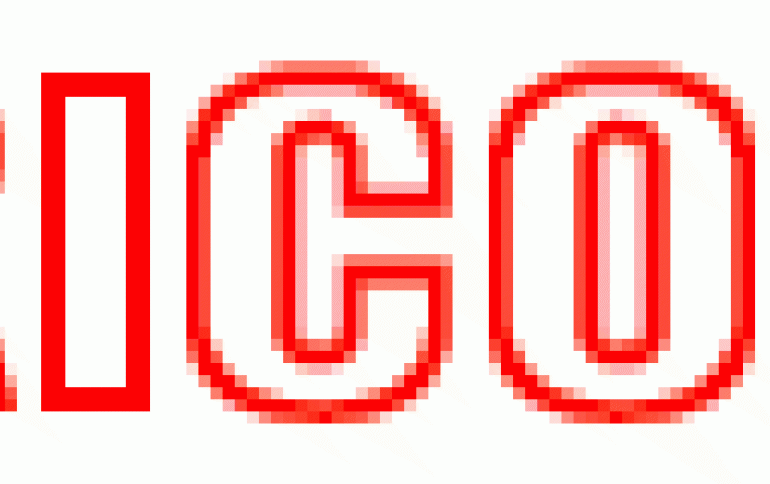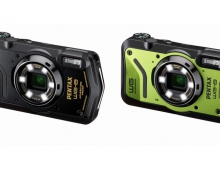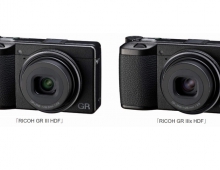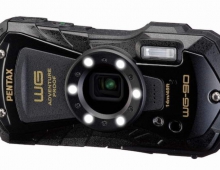
Ricoh Launches New 8.5-GB DVD+R DL And 16X / 4X DL DVD Drive
Ricoh Europe B.V. (EPMMC Center) announced the launch of a new product line of single-sided DVD+R DL (Double Layer) discs and a compatible recordable DVD drive, the Ricoh MP5316DA.
These recordable DVDs feature a capacity of 8.5 GB, about 1.8 times larger than current DVDs, and provide superior playback compatibility with existing DVD players.
The DVD+R DL discs have two single-sided DVD+R recording layers that meet the write-once DVD standards and provide superior compatibility with playback devices in existing DVD players. The 8.5-GB capacity of these discs is 1.8 times larger than current single-layer discs for enabling approximately four hours of video recording at regular DVD quality.
*Standard image quality (bit rate: 4.5 Mbps)
Ricoh utilizes its exclusive Inverted Stack manufacturing process and new high-precision stamper with its Advanced SD Dye _ type recording elements to produce these two-layer discs at a low price with high-reliability recording quality, superior compatibility, and durability.
The Ricoh MP5316DA is a high-performance internal drive that supports DVD+RW/+R and DVD-R/-RW discs and is capable of 16x-speed writing (+R/-R), 4x-speed writing for DL (double-layer) discs, and 4x-speed rewriting (+RW/-RW).
Main Features of Ricoh DVD+R DL Discs
1. Gigantic 8.5 GB capacity while maintaining compatibility with DVD players
The two recording layer structure enables a tremendous capacity of 8.5 GB, approximately 1.8 times larger than single-layer discs. This makes them suitable not only for large data backups, but also extended hours of video recording (approx. 4 hours at 4.5 Mbps).
These discs are compatible with double-layer DVD-Video/DVD-ROM discs and can be read by existing DVD players and DVD-ROM drives. (They may not be readable with some playback devices.)
2. Ricoh?s exclusive Inverted Stack manufacturing process enables a low price with high-reliability recording quality
Ricoh?s exclusive Inverted Stack manufacturing process can be utilized for low-cost and mass production, and enables dramatic improvements in testing control accuracy of the recording film. This enables us to provide discs at a low price with high-reliability recording quality.
3. New Advanced SD Dye ? type recording elements for superior durability
These discs feature stable recording, high sensitivity, and excellent durability.
Main Features of Ricoh MP5316DA
1. Compatible with DVD+R DL
This drive is compatible with large-capacity DVD+R DL (Double Layer) discs. Writing is possible at 4x speed in addition to the standard 2.4x writing speed.
2. High-speed recording capability to DVD+R and DVD-R discs
Writing speeds are at the industry?s highest level, with 16x-speed writing for DVD+R (single-layer)/DVD-R discs. This drive utilizes the full CAV technique to complete writing of a single DVD in approximately 6 minutes (theoretical value).
Of course, high-speed writing and rewriting to DVD+RW/DVD-RW and CD-R/RW are also possible. (This drive supports 4x-speed writing for DVD+RW/ DVD-RW, 48x-speed for CD-R, and 24x-speed writing for CD-RW.)
3. High compatibility, exceptional user-friendliness, and rich collection of bundled software allow this drive to be used in a wide range of applications from creation of original DVDs to storing of computer data.
For video applications, not only is DVD playback possible, but this drive can also be used for capture from digital video cameras (DV input interface required), video editing, creation of original DVDs.
This drive is ideal for daily data storage and backup. DVD+R DL discs enable high-speed back-ups of those massive files on your hard drive that cannot be saved into a single-layer disc.
Inverted Stack Manufacturing System
Single-layer DVD+R discs have a structure consisting of a substrate + recording layer + reflective layer + substrate. Double-layer discs, on the other hand, require two recording layers and two reflective layers and have a structure consisting of substrate + recording layer 1 + semi-transparent reflective layer + intermediate plastic layer + recording layer 2 + reflective layer + substrate.
In contrast to the "layered system? in which discs are manufactured by stacking all the layers on top of a substrate, the new "inverted stack system? manufactures a disc A consisting of the substrate ~ the semi-transparent reflective layer and a disc B consists of recording layer 2 ~ the substrate, and then adhere these two discs together to make a single disc.
Some advantages of this system are
(1) Manufacturing of discs A and B proceeds in parallel up to the adhesion process, so it enables a high volume production;
(2) In the "layered system?, a stamper needs to be peeled off between the formation processes of the two recording layers. This process requires a plastic stamper. The Inverted Stack Manufacturing System, however, can use a regular metal stamper with high durability at lower costs; and
(3) Since discs A and B are manufactured independently and adhered at the end of the process, the testing precision can be dramatically improved.
Ricoh?s exclusive Inverted Stack System overcomes these technical obstacles and provides high-reliability DVD+R DL discs at a reasonable price.
The technical challanges to deal this were, the wobble (spiral grooves), which is required for each recording layer, is created in disc A between the substrate and recording layer in the same way as a single-layer disc. In disc B, on the other hand, the wobble must be created between the reflective layer and substrate. This results in different structures for discs A and B and requires advanced design technology. In addition, the wobble in disc B is located in the farthest point from the pickup, so the disc requires a sharper and more recise groove formation and a high-precision stamper.
The DVD+R DL discs have two single-sided DVD+R recording layers that meet the write-once DVD standards and provide superior compatibility with playback devices in existing DVD players. The 8.5-GB capacity of these discs is 1.8 times larger than current single-layer discs for enabling approximately four hours of video recording at regular DVD quality.
*Standard image quality (bit rate: 4.5 Mbps)
Ricoh utilizes its exclusive Inverted Stack manufacturing process and new high-precision stamper with its Advanced SD Dye _ type recording elements to produce these two-layer discs at a low price with high-reliability recording quality, superior compatibility, and durability.
The Ricoh MP5316DA is a high-performance internal drive that supports DVD+RW/+R and DVD-R/-RW discs and is capable of 16x-speed writing (+R/-R), 4x-speed writing for DL (double-layer) discs, and 4x-speed rewriting (+RW/-RW).
Main Features of Ricoh DVD+R DL Discs
1. Gigantic 8.5 GB capacity while maintaining compatibility with DVD players
The two recording layer structure enables a tremendous capacity of 8.5 GB, approximately 1.8 times larger than single-layer discs. This makes them suitable not only for large data backups, but also extended hours of video recording (approx. 4 hours at 4.5 Mbps).
These discs are compatible with double-layer DVD-Video/DVD-ROM discs and can be read by existing DVD players and DVD-ROM drives. (They may not be readable with some playback devices.)
2. Ricoh?s exclusive Inverted Stack manufacturing process enables a low price with high-reliability recording quality
Ricoh?s exclusive Inverted Stack manufacturing process can be utilized for low-cost and mass production, and enables dramatic improvements in testing control accuracy of the recording film. This enables us to provide discs at a low price with high-reliability recording quality.
3. New Advanced SD Dye ? type recording elements for superior durability
These discs feature stable recording, high sensitivity, and excellent durability.
Main Features of Ricoh MP5316DA
1. Compatible with DVD+R DL
This drive is compatible with large-capacity DVD+R DL (Double Layer) discs. Writing is possible at 4x speed in addition to the standard 2.4x writing speed.
2. High-speed recording capability to DVD+R and DVD-R discs
Writing speeds are at the industry?s highest level, with 16x-speed writing for DVD+R (single-layer)/DVD-R discs. This drive utilizes the full CAV technique to complete writing of a single DVD in approximately 6 minutes (theoretical value).
Of course, high-speed writing and rewriting to DVD+RW/DVD-RW and CD-R/RW are also possible. (This drive supports 4x-speed writing for DVD+RW/ DVD-RW, 48x-speed for CD-R, and 24x-speed writing for CD-RW.)
3. High compatibility, exceptional user-friendliness, and rich collection of bundled software allow this drive to be used in a wide range of applications from creation of original DVDs to storing of computer data.
For video applications, not only is DVD playback possible, but this drive can also be used for capture from digital video cameras (DV input interface required), video editing, creation of original DVDs.
This drive is ideal for daily data storage and backup. DVD+R DL discs enable high-speed back-ups of those massive files on your hard drive that cannot be saved into a single-layer disc.
Inverted Stack Manufacturing System
Single-layer DVD+R discs have a structure consisting of a substrate + recording layer + reflective layer + substrate. Double-layer discs, on the other hand, require two recording layers and two reflective layers and have a structure consisting of substrate + recording layer 1 + semi-transparent reflective layer + intermediate plastic layer + recording layer 2 + reflective layer + substrate.
In contrast to the "layered system? in which discs are manufactured by stacking all the layers on top of a substrate, the new "inverted stack system? manufactures a disc A consisting of the substrate ~ the semi-transparent reflective layer and a disc B consists of recording layer 2 ~ the substrate, and then adhere these two discs together to make a single disc.
Some advantages of this system are
(1) Manufacturing of discs A and B proceeds in parallel up to the adhesion process, so it enables a high volume production;
(2) In the "layered system?, a stamper needs to be peeled off between the formation processes of the two recording layers. This process requires a plastic stamper. The Inverted Stack Manufacturing System, however, can use a regular metal stamper with high durability at lower costs; and
(3) Since discs A and B are manufactured independently and adhered at the end of the process, the testing precision can be dramatically improved.
Ricoh?s exclusive Inverted Stack System overcomes these technical obstacles and provides high-reliability DVD+R DL discs at a reasonable price.
The technical challanges to deal this were, the wobble (spiral grooves), which is required for each recording layer, is created in disc A between the substrate and recording layer in the same way as a single-layer disc. In disc B, on the other hand, the wobble must be created between the reflective layer and substrate. This results in different structures for discs A and B and requires advanced design technology. In addition, the wobble in disc B is located in the farthest point from the pickup, so the disc requires a sharper and more recise groove formation and a high-precision stamper.





















